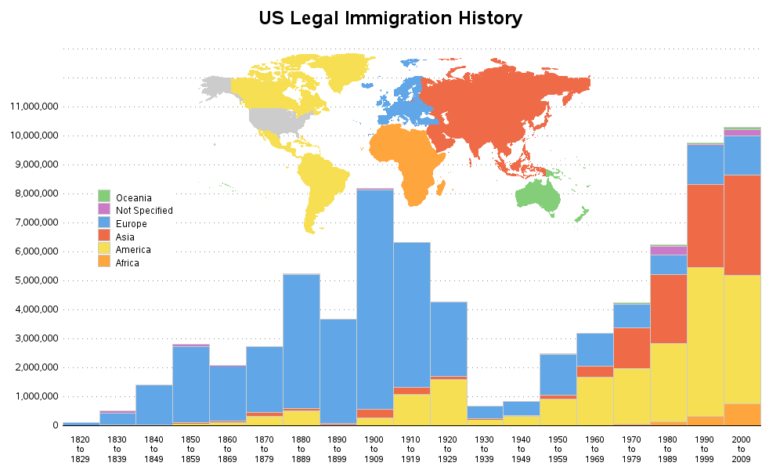The Immigration Graph

Immigration is a critical factor in Canada’s economy. With the labour force aging and job vacancies rising, immigration plays an important role in ensuring the country has the right amount of workers to meet demand.
This graph provides a look at international migration patterns over time. It shows how migration is shaped by economic, geographic and demographic factors.
Origins
Over time, immigration has driven changes in the United States demographically, economically, culturally and socially. Newcomers have played an important role in the establishment of the British colonies and westward expansion, the rise of cities and manufacturing in the 19th century and the dominance of a services-based economy beginning in the 1970s and continuing today.
During the Colonial period, many immigrants arrived voluntarily to trade or settle for religious reasons. Other groups, such as English convicts and African slaves, came to the US under duress or were forcefully transported here.
Between 1820 and 1860, the number of immigrants in the US increased dramatically due to the influx of Europeans. Most of these people were Irish, German and British. Some were fleeing crop failure and famine in their home countries, while others came to the United States in search of land for farming.
However, a major factor that influenced immigration was the need for cheap labor. The rapid growth of the industrial economy made the need for immigrant labor more pressing than ever before.
Despite these economic pressures, the United States remained highly selective in allowing immigrants into the country. During the 1920s, Congress passed the National Origins Act that put a quota on the number of immigrants who could enter the United States and required all immigrants to pass a test for literacy.
The law also made it difficult for immigrants to obtain employment in the United States. In addition, the law barred immigrants from certain parts of China and the West Coast.
These laws prompted an outcry from citizens who believed that immigrants were stealing jobs, lowering wages and threatening the economy. Eventually, the nation’s leaders realized that they needed to change their immigration policies.
By 1965, Congress had passed the Hart-Cellar Act. This changed the immigration laws by removing strong preferences for European migration and replacing them with a system that favored family unification, as well as immigration from Asia and Latin America.
The Hart-Cellar Act shifted the origins of immigrant waves, as well as the destination of most people who immigrated to the United States. Most people who immigrated to the US in the 20th century came from Europe, but since the 1965 immigration laws have been passed, immigrants have primarily come from Asia and Latin America.
Flows
The flows of international migration, particularly labour migration, are shaped by a variety of factors. They are driven by people’s personal aspirations, but also by events such as public-health crises, global or regional armed conflicts, and economic shocks.
Migrants usually move within their home regions, although they can cross long distances to settle in a new country. Most international migrants travel to richer countries, but a substantial share of immigrants come from developing economies and emerging markets towards advanced nations.
As international flows of migrants increase, they can polarize political debates in both sending and receiving countries. This is especially true in Europe, where growing migrant populations fuel nationalist and nativist political parties and divide voters’ views of the role of immigrants in society.
In richer countries, immigrants can add to a nation’s economic output through their remittances and by providing low-cost services that enable native-born citizens to enter the labor market. Developing nations can benefit from immigration as well, as it helps their economies thrive by leveraging the expertise of foreign workers.
But many international migration flows are missing from official data, making it difficult to measure the true extent of emigration and migration trends. Some countries collect flow data, but their definitions of a migrant are inconsistent and their methods of collecting such data are expensive.
Eurostat produces statistics on a range of issues related to international migration flows, non-national population stocks and the acquisition of citizenship. The statistical authorities of EU Member States and EFTA countries supply the agency with migration flow data.
Our method of estimating migration flows from reported data uses six common measures: counts, logarithms of counts, proportions, weights for detection of migrant network structures and base-level measures for inputs into population projection models (immigration and emigration rates). Estimates that are statistically independent of reported data will have a sample correlation not far from zero; estimates that are weakly associated with reported flows will have a lower correlation.
To estimate migration flows from reported data, we use a set of routines in R developed by G.J.A. and published in Abel (2013). These routines use migrant stock data to generate synthetic estimates of bilateral flows between all pairs of countries. The resulting estimates are then correlated with available reported data to evaluate their validity as indicators of the number of migrants and migrant stock in a country.
Trends
The immigration graph reflects the overall changes in the immigrant population across the United States over time. It shows that the foreign-born population has moved beyond traditional gateways, such as California, Florida, Illinois, New Jersey, and Texas, and into areas of the country that were previously home to native born Americans.
Despite some popular beliefs that immigrants compete with the native population for jobs and therefore depress wages, immigration has had a minimal impact on average earnings. Instead, the influx of workers has changed relative supplies of low-skilled and high-skilled labor.
First, it has increased the supply of workers without a high school degree and of those at the higher end of the education spectrum–those with a college or postgraduate degree. This is a relatively small effect for workers without a high school degree, but it has had a larger and more persistent impact for those with a college or postgraduate degree.
In addition, immigrants have made a significant contribution to the nation’s social fabric by establishing schools and hospitals, boosting public services, and providing opportunities for American children. They have also broadened the cultural outlook and, at times, defined American culture through literature, music, and art (see Table 1).
Third, it has led to economic growth in the United States by increasing consumer demand for goods and services and by raising productivity in industries that benefit from high-skilled immigrants’ expertise. In particular, the influx of migrants has helped to raise labour-force participation rates and stimulate employment in the service and technology sectors.
Fourth, it has benefited the countries of origin by enabling people to move to more prosperous economies and improve their quality of life. During periods of rapid economic and technological change, such as the Industrial Revolution in the United States and other parts of the developed world, immigrants have been able to relocate to the most prosperous countries and contribute to their growth.
Fifth, it has benefited the destination countries by attracting and employing migrant workers in essential sectors that are hard to fill by domestic workers. For example, during the recent outbreak of avian influenza, at least 7 OECD countries relied on migrant healthcare workers to provide care and treatment.
Conclusions
The immigration graph is a visual reminder of the complexities and wide range of people settling in the United States. This includes naturalized citizens, lawful permanent residents (LPRs), persons on student or work visas, and refugees, among others.
The graph displays the number of immigrants in the United States and their share of the population over time. It also provides an opportunity to consider the stories behind this historical migration.
One key conclusion is that the overall economic impact of immigrants can be substantial. These effects can be amplified by appropriate labor market and integration policies.
Second, a more equitable distribution of the gains from migration is essential. This can be achieved by ensuring that immigration policies do not disproportionately benefit the most well-off, or by enhancing the incentives for those who may face temporary difficulties to adjust to a new country.
Third, migration into advanced economies can contribute to rapid gains in output and productivity. This is because the skills of immigrant workers are often complementary to the ones that natives have.
Fourth, the relative income gap between advanced and emerging market and developing economies (EMDEs) is still quite large. Nevertheless, this gap has significantly narrowed in recent decades due to growth in EMDEs and will continue to shrink under a baseline scenario.
Fifth, conflicts and climate-related disasters can amplify emigration, although the evidence is limited. These factors can be addressed through international cooperation, and the effects of emigration can be tempered by measures to strengthen domestic institutions and support development.
Sixth, immigrants in the United States have different levels of educational attainment. For example, immigrants from Mexico and Central America were less likely to have a high school diploma than the U.S. born, while immigrants from South Asia and other regions were as or more likely to have a bachelor’s or advanced degree than the U.S. born.
The immigration graph suggests that the macroeconomic impact of immigrants is considerable. This can be amplified by appropriate labor market, retraining and integration policies, which are associated with increased employment growth following large immigration waves.




